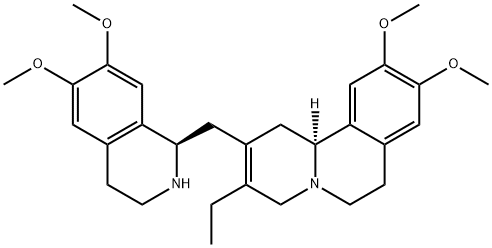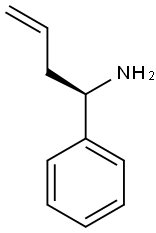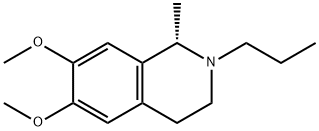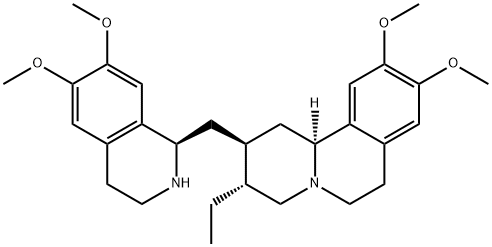dehydroemetine
- CAS NO.:4914-30-1
- Empirical Formula: C29H38N2O4
- Molecular Weight: 478.62
- MDL number: MFCD01729551
- EINECS: 2255427
- SAFETY DATA SHEET (SDS)
- Update Date: 2024-11-16 15:32:52

What is dehydroemetine?
Definition
ChEBI: Dehydroemetine is a pyridoisoquinoline which was developed in response to the cardiovascular toxicity associated with emetine and results from the dehydrogenation of the heterotricylic ring of emetine. It is an antiprotozoal agent and displays antimalarial, antiamoebic, and antileishmanial properties. It has a role as an antiprotozoal drug, an antimalarial and an antileishmanial agent. It is a member of isoquinolines, an aromatic ether and a pyridoisoquinoline. It derives from a hydride of an emetan.
Pharmaceutical Applications
The synthetic racemic derivative of the plant alkaloid
emetine. Formulated as the hydrochloride for intramuscular
administration.
Like the parent compound, emetine, it
inhibits
E. histolytica at concentrations of 1–10 mg/L in vitro,
but it is more active than the parent in animal models. Drugresistance
in E. histolytica is rare.
No human pharmacokinetic data are available. A halflife
of 2 days, compared with 5 days for emetine, has been
reported. There is selective tissue binding and accumulation
in the liver, lung, spleen and kidney.
It is considerably less toxic than emetine, possibly because
it is more rapidly eliminated. Nevertheless, nausea, vomiting,
diarrhea and abdominal cramps frequently occur.
Neuromuscular effects have also been reported. More serious
cardiotoxic effects can lead to electrocardiogram (EGG)
changes, tachycardia and a drop in blood pressure.
It was formerly used as a second-line treatment in severe
intestinal or hepatic amebiasis, but is no longer recommended
for use.
Properties of dehydroemetine
| Melting point: | 94-96° |
| alpha | D -183° |
| Boiling point: | 604.7±55.0 °C(Predicted) |
| Density | 1.19±0.1 g/cm3(Predicted) |
| storage temp. | Store at -20°C |
| pka | 8.86±0.40(Predicted) |
| form | Solid |
| color | Off-white to light yellow |
Safety information for dehydroemetine
Computed Descriptors for dehydroemetine
New Products
Tert-butyl bis(2-chloroethyl)carbamate 4-Methylphenylacetic acid N-Boc-D-alaninol N-BOC-D/L-ALANINOL 3-Morpholino-1-(4-nitrophenyl)-5,6-dihydropyridin- 2(1H)-one Furan-2,5-Dicarboxylic Acid Tropic acid 1,1’-CARBONYLDIIMIDAZOLE DIETHYL AMINOMALONATE HYDROCHLORIDE R-2-BENZYLOXY PROPIONIC ACID 1,1’-CARBONYLDI (1,2-4 TRIAZOLE) N-METHYL INDAZOLE-3-CARBOXYLIC ACID (2-Hydroxyphenyl)acetonitrile 4-Bromopyrazole 5-BROMO-2CYANO PYRIDINE 5,6-Dimethoxyindanone 5-broMo-2-chloro-N-cyclopentylpyriMidin-4-aMine 2-(Cyanocyclohexyl)acetic acid 4-methoxy-3,5-dinitropyridine 2-aminopropyl benzoate hydrochloride 1-(4-(aminomethyl)benzyl)urea hydrochloride diethyl 2-(2-((tertbutoxycarbonyl)amino) ethyl)malonate tert-butyl 4- (ureidomethyl)benzylcarbamate Ethyl-2-chloro((4-methoxyphenyl)hydrazono)acetateRelated products of tetrahydrofuran




You may like
-
 2033-24-1 98%View Details
2033-24-1 98%View Details
2033-24-1 -
 1975-50-4 98%View Details
1975-50-4 98%View Details
1975-50-4 -
 2-HYDROXY BENZYL ALCOHOL 98%View Details
2-HYDROXY BENZYL ALCOHOL 98%View Details
90-01-7 -
 2-Chloro-1,3-Bis(Dimethylamino)Trimethinium Hexafluorophosphate 221615-75-4 98%View Details
2-Chloro-1,3-Bis(Dimethylamino)Trimethinium Hexafluorophosphate 221615-75-4 98%View Details
221615-75-4 -
 61397-56-6 CIS BROMO BENZOATE 98%View Details
61397-56-6 CIS BROMO BENZOATE 98%View Details
61397-56-6 -
 14714-50-2 (2-Hydroxyphenyl)acetonitrile 98+View Details
14714-50-2 (2-Hydroxyphenyl)acetonitrile 98+View Details
14714-50-2 -
 118753-70-1 98+View Details
118753-70-1 98+View Details
118753-70-1 -
 733039-20-8 5-broMo-2-chloro-N-cyclopentylpyriMidin-4-aMine 98+View Details
733039-20-8 5-broMo-2-chloro-N-cyclopentylpyriMidin-4-aMine 98+View Details
733039-20-8